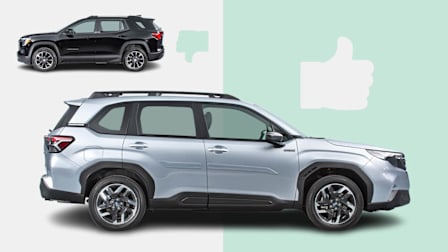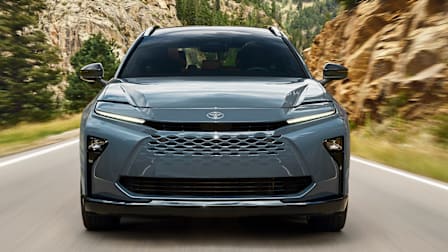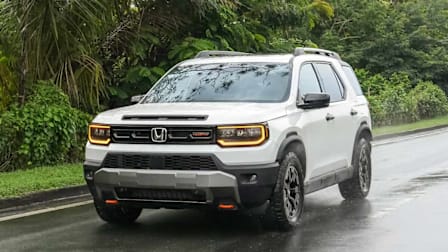Preview: Redesigned 2024 BMW X2 Grows Larger and Gains More Tech
More cargo room, expanded voice-activated controls, and standard driver assistance are among the improvements promised by BMW
The 2024 BMW X2 is larger than the outgoing model, adding some rear seat room, a longer wheelbase, and a significant increase in cargo space.
The boost in size also contributes to a beefier look to the model, which gets styling updated to match the rest of BMWs model lineup. It continues to be the coupe-like version of the X1 SUV, which was redesigned for 2023.
In This Article
CR’s Take • Outside • Inside • What Drives It • Active Safety and Driver Assistance
Despite its larger dimensions, the new body is lighter but stiffer than that of its predecessor, which BMW says will improve cornering performance. For those interested in more sporty performance overall, an M Sport version will be offered with a more powerful engine, bigger brakes, and an adaptive suspension system, among other upgrades.
CR's Take
The arrival of a bigger X2 will come as good news to prospective buyers who liked the previous generation’s driving characteristics but balked at its cramped back seat and cargo area, as well as its severely compromised rear visibility. The 2024 model has almost four cubic feet more cargo room behind the rear seats than the 2022 model (for a total of more than 25 cubic feet), and the new model also gets a little extra knee room.
The big news, though, is all of the tech upgrades being jammed into the X2. The new version offers all of the high-tech offerings introduced in BMW’s flagship i7 a few years ago (some are optional, of course), including the digital cockpit, augmented navigation, expanded digital streaming capabilities, and a camera- and radar-based driver assistance system.
Hopefully, the new model’s more generous sizing doesn’t come at the expense of the outgoing one’s nimble handling. If the much-improved new X1 is any indication, the latest version of the X2 is likely to be a satisfying blend of performance, utility, and small-car practicality.
Outside
The new X2 takes on a more blocky appearance than its predecessor, with a taller, upright grille, slabbier sides, a taller-looking greenhouse, and standard 19-inch wheels. The front end has a more cartoonish aspect, with bigger, more stylized grille openings, flared wheel arches, and angular LED head- and tail-lamp assemblies. A range of sparkly metallic paint colors are joined by a pair of more muted solids.
The M Sport trim gets more body-colored moldings, standard 20-inch wheels (21-inch wheels are optional), a rear spoiler and rear diffuser to aid aerodynamics, and a suite of interior and exterior M badging. The M Sport Professional Package—available on both the base xDrive28i and the M35i xDrive—adds some black accents, as well as a choice of red, blue, or gray four-piston brake calipers.
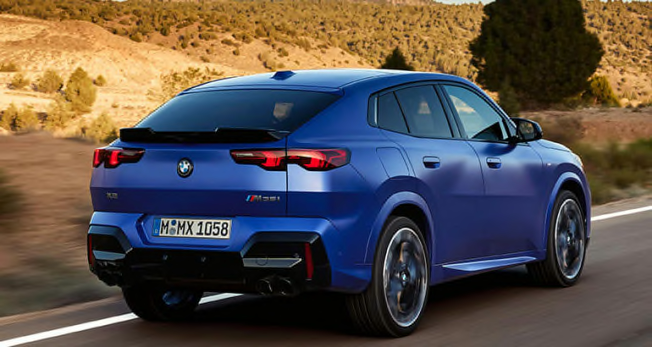
Photo: BMW Photo: BMW
Inside
BMW says that many of the interior design details are carried over from the BMW iX, including a floating center armrest, and a long digital display screen that curves toward the driver, incorporating both the center infotainment screen and driver instrumentation. An accent spear lives below the screen; its material depends upon trim level.
The infotainment system comes with BMW’s latest operating system, which can be used with voice commands. The system was developed with Android Open Source Project software and offers access to BMW’s newer subscription-based digital upgrades, including streaming music, video, and gaming. For example, passengers can use the curved screen as a gaming console and control the action with their smartphone.
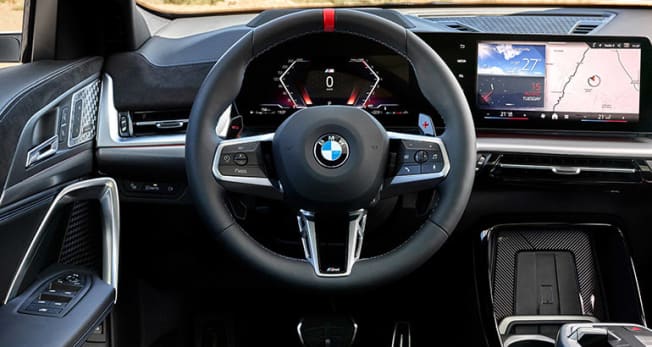
Photo: BMW Photo: BMW
The infotainment home screen has also been redesigned, along with the menu that allows quicker access to commonly used infotainment features. BMW says the new operating system has allowed it to reduce the number of physical switches and buttons in the car, although the gear selector and other buttons can still be found on the center console.
Redesigned seats feature better lateral support and a higher seating position. They come in a variety of colors, including black, brown, gray, and a pair of two-tone options: black and red, and gray and smoke white. Sport seats are optional, as is panoramic roof glass.
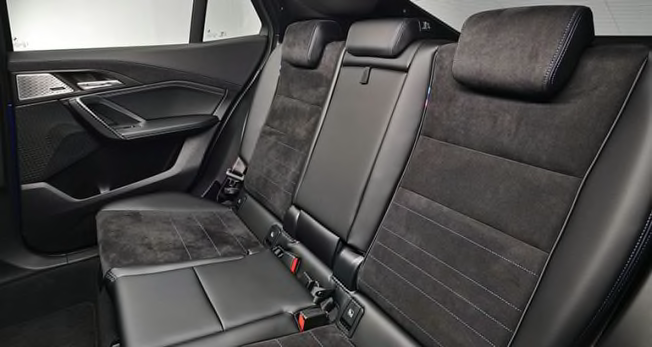
Photo: BMW Photo: BMW
What Drives It
The entry-level engine, offered in the base xDrive28i trim, is an updated version of the 2.0-liter turbocharged four-cylinder—it makes 241 horsepower. Peak torque—295 lb.-ft.—comes on low in the power band, at 1,500 rpm, and stretches to 4,000 rpm. BMW says this engine will propel the X2 from zero to 60 mph in 6.2 seconds.
The sportier M35i xDrive trim comes with a 312-hp variant of the turbocharged 2.0-liter capable—according to BMW—of a 5.2-second launch from zero to 60 mph. The more powerful engine has the same peak torque output as the base one, albeit at a slightly higher rpm range. Like BMW’s other M-trimmed models, the X2 gets a throatier-sounding exhaust system with a matched pair of twin tailpipe tips peeking out from below the rear bumper.
Both engines come with a double-clutch seven-speed automatic transmission, with paddle shifters for quick gear changes. The transmission automatically shifts into Park whenever the car is shut off, and the electronic parking brake applies automatically when the X2 is parked on a slope. All-wheel drive is standard.
BMW redesigned the suspension, along with the front and rear axles to improve cornering performance, handling, and ride comfort. As an added benefit, smaller springs and dampers were incorporated into the new setup to help maximize interior space.
Active Safety and Driver Assistance
The new X2 comes standard with forward collision warning (FCW) that can identify pedestrians and cyclists, automatic emergency braking (AEB), and a blind spot warning (BSW) system, along with an exit warning system that will alert the driver if a cyclist or vehicle is approaching from the rear, to prevent hitting them when opening a door or turning.
An optional camera- and radar-based driver assistance system handles adaptive cruise control with steering assist, and can bring the car to a complete stop if necessary. Under 40 mph, the system allows hands-free driving on limited-access highways. Parking assist, backup assist, and a 360-degree surround-view camera system are also available. The parking assist system includes a feature that uses the car’s exterior cameras to record up to 60 seconds of footage in a crash. The surround-view cameras will also record video if the car’s alarm is activated.

















